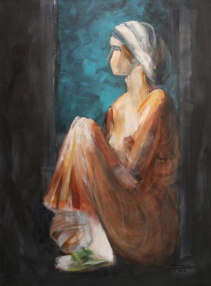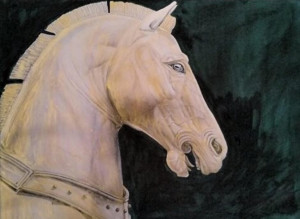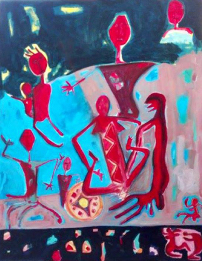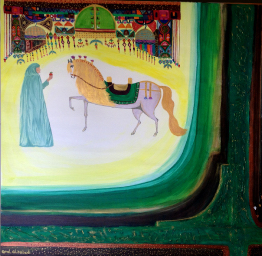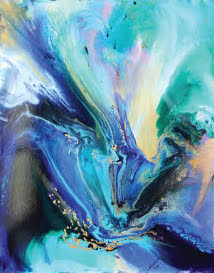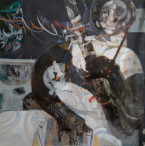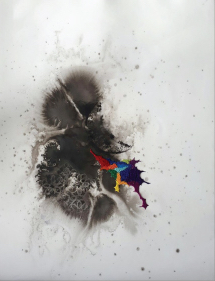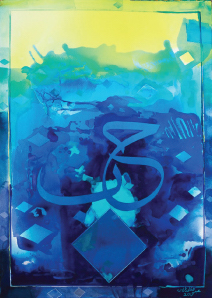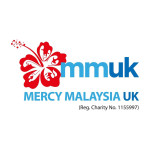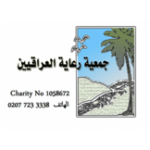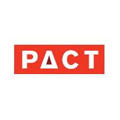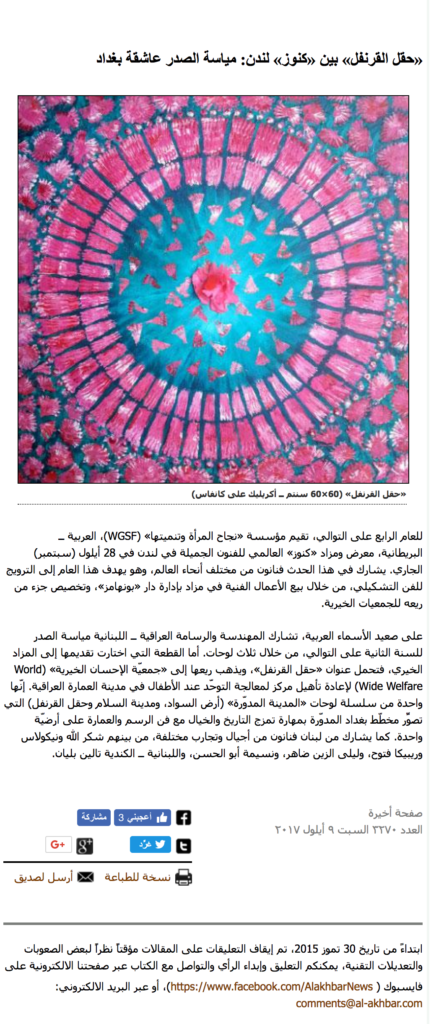
- This event has passed.
4th Konooz Fine Art Auction
January 28, 2017 8:00 am - 5:00 pm
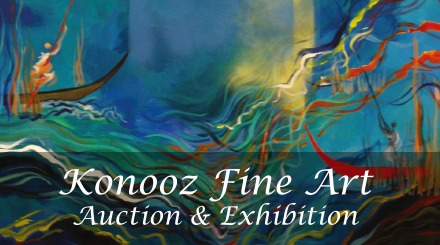
Welcome to 4th Koonoz Fine Art Auction London 2017. We are excited to be hosting an array of star names from the world of art and beyond, a wealth of returning artists alongside fresh new faces who are approaching the event with great enthusiasm.We’ll be enjoying a fantastic selection work from pioneer artists from across the globe including; Algeria, Egypt, France, Iraq, Lebanon, Monaco, the Sultanate of Oman, Romania, Saudi Arabia, Tunisia and the United Arab Emirates.Although there are conflicts all over the world, when it comes to art it has power, it has the ability to change hearts and minds, giving lots of pleasure by sharing these experiences with the right people.
Our main target this year is to promote the artists works, alongside our usual aim of raising funds for charities. Through huge media coverage, together with the art collectors and art lovers attendance, we can achieve our objective in a harmonious atmosphere surrounded by love, art and giving.
Partners
Intercraft
Bonhams
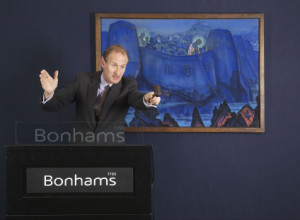 Giles Peppiatt is a director of Bonhams and has been conducting auctions for over twenty years. He currently manages the sales of Modern and Contemporary African Art and will be overseeing the Bonham’s auction “The Art of the Maghreb” scheduled for later in 2017.
Giles Peppiatt is a director of Bonhams and has been conducting auctions for over twenty years. He currently manages the sales of Modern and Contemporary African Art and will be overseeing the Bonham’s auction “The Art of the Maghreb” scheduled for later in 2017.
Venue
The Lanesborough
Hyde Park Corner
London
SW1X 7TA
Mayassah AlSader is an Iraqi British Landscape Architect and Artist. She holds a Masters degree in History of Landscape Architecture from UT Austin and currently working with the renowned Vladimir Djurovic Landscape Architecture firm in Lebanon. Despite living in the diaspora, Mayassah stays passionate about the present and past of Iraq and dedicates her art work to depict both.
FROM THE ROUND CITY SERIES, ACRYLICS ON CANVAS, 60x60cm, 2017
This Series is based on the plan of round city of Baghdad (762 CE) blending art, architecture and history on one canvas.
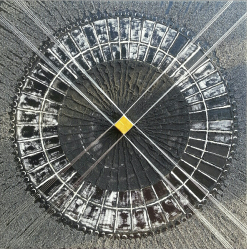 LAND OF BLACK ارض السواد
LAND OF BLACK ارض السواد
Iraq was known as the “land of black” due to the density of its greenery and buildings. Years of wars had burned the buildings into skeletons and the greenery into ashes. The heavily fortified walls of the city vanished into footprints opening the way to terror and destruction. Alone the house of power stands above the ruins, controlled by strings from behind the borders, like a marionette.
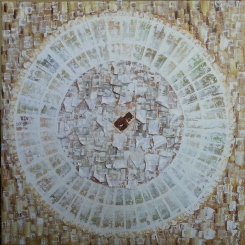 CITY OF PEACE مدينة السلام
CITY OF PEACE مدينة السلام
Once upon a time, Baghdad was known as the “city of peace.” Today, in this painting the city says “I will raise all the white flags in the world, just give me some peace.”
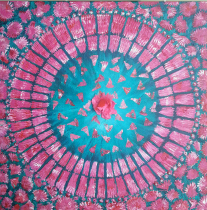 FIELD OF CARNATION حقل القرنفل
FIELD OF CARNATION حقل القرنفل
Present in most Arab gardens, Carnations expresses love and fascination. This painting represents a window for imagination and a slice of a dream of a garden of resurrection.
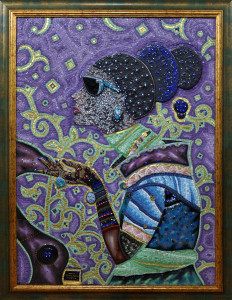
Master of Arts George Enescu University of Arts of Iași, Romania
Personal Exhibitions from January 2000 to the present day in London, Paris, Chambery, Grenoble, Bucharest, Iași Owner at SC. Piticariu Art&Style; SRL (est. 2000) making Stained Glass, Tiffany Lamps, Glass Fusing and Artistic Mosaic. Has created works for Churches, official buildings and private houses.
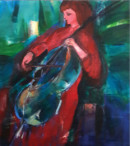 Laila is a multi-talented artist with an ever-growing sense of art. She was born in Lebanon, a professional artist since her childhood. She became popular thanks to her diversified paintings (acrylics, oil, pastel, watercolour and ink), she was passionate and discovered her talent at a young age. Her work has been showing in many countries since 1998 She graduated in Fine Arts in Lebanon in 1989. She graduated in Fine Arts USA 2003-2005. A member of the UAE Fine Arts Association and a founder of UAE Fine Arts Movement since the 1980s.
Laila is a multi-talented artist with an ever-growing sense of art. She was born in Lebanon, a professional artist since her childhood. She became popular thanks to her diversified paintings (acrylics, oil, pastel, watercolour and ink), she was passionate and discovered her talent at a young age. Her work has been showing in many countries since 1998 She graduated in Fine Arts in Lebanon in 1989. She graduated in Fine Arts USA 2003-2005. A member of the UAE Fine Arts Association and a founder of UAE Fine Arts Movement since the 1980s.
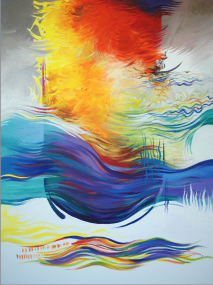 Fifty years with formative arts, practice and intensive development, practical experience with all kinds of paintings: oil colour, watercolour, charcoal, pencil etc. Participated in more than a hundred national and international art exhibitions in many countries. Many of his paintings have been printed as posters, greeting cards and calendars. 2006 Honoured among the avant-garde artists in the 25th Emirates Fine Arts Society Anniversary. 2003 Master of Fine Arts (Hon), Elam School of Fine Arts, The University of Auckland, New Zealand. 1994 Founder of the Wall Group Fine Arts UAE 1980 Founder member of the “Emirates Fine Arts Society” UAE 1974 Member of the “Iraqi Artist Union” Baghdad, Iraq
Fifty years with formative arts, practice and intensive development, practical experience with all kinds of paintings: oil colour, watercolour, charcoal, pencil etc. Participated in more than a hundred national and international art exhibitions in many countries. Many of his paintings have been printed as posters, greeting cards and calendars. 2006 Honoured among the avant-garde artists in the 25th Emirates Fine Arts Society Anniversary. 2003 Master of Fine Arts (Hon), Elam School of Fine Arts, The University of Auckland, New Zealand. 1994 Founder of the Wall Group Fine Arts UAE 1980 Founder member of the “Emirates Fine Arts Society” UAE 1974 Member of the “Iraqi Artist Union” Baghdad, Iraq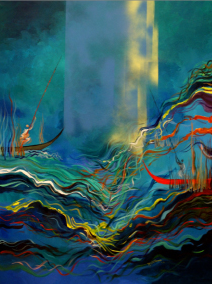 Collectors
Collectors
H.H. Al-Sheikh Dr Sultan Al – Qasmy Ruler of Sharjah; Sharjah Art Museum – United Arab Emirates; Cultural Foundation in Abu Dhabi in UAE; Ajman Emirate – Ruler Palace; Abu Dhabi National Oil Company (ADNOC); Many Companies, Embassies, Banks, Art Collectors and VIP inside and outside the United Arab Emirates have his works. Thousands of his printed paintings are spread worldwide.
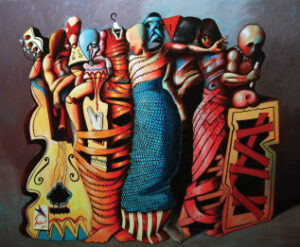 Work of the artist is the embodiment of dreams in the form of vague messages philosophical metaphysical dimension. They use sensual colours and expressions for form a combination of surreal, deconstruction and synthetic artworks.
Work of the artist is the embodiment of dreams in the form of vague messages philosophical metaphysical dimension. They use sensual colours and expressions for form a combination of surreal, deconstruction and synthetic artworks.
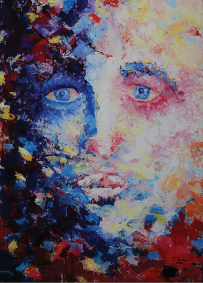 She experiments with portraits, attempting to revive intense emotions with regards to social problems. Humans throughout their existence developed ways to cope with the real world atrocities, this fact led to a quick embrace of social media as it offered a great alternative to a so-called “perfect world”. The overwhelming setup of that virtual world is gradually leading to humans to a peak of a collective blindness. This loss of the sense of humanity is leading her to hook with the use of organic tools such as painting, as we can see through her deeply emotional portraits. Her work has been showing in many countries since 1998. http://www.talinebalian.com
She experiments with portraits, attempting to revive intense emotions with regards to social problems. Humans throughout their existence developed ways to cope with the real world atrocities, this fact led to a quick embrace of social media as it offered a great alternative to a so-called “perfect world”. The overwhelming setup of that virtual world is gradually leading to humans to a peak of a collective blindness. This loss of the sense of humanity is leading her to hook with the use of organic tools such as painting, as we can see through her deeply emotional portraits. Her work has been showing in many countries since 1998. http://www.talinebalian.com
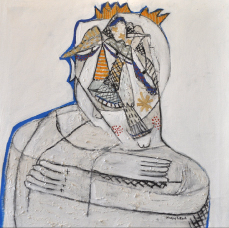 Born in 1994, Nicolas started to write stage plays at a very young age and direct them with the help of some school friends. He used to create the sets and costumes himself. At the age of twelve he started to paint. Later he studied animation because he always loved to tell stories, make people dream and take them into fantasy worlds. He graduated from the Academy Libanaise Des Beaux Arts first of his class in 2015. He has exhibited his paintings in different countries: Lebanon (Beirut, Jbeil), USA (Santa Ana), UAE (Dubai, Abu Dhabi), Saudi Arabia (Jeddah), Italy (Milan), France (Paris), England (Bonham’s – London), Sultanate of Oman (Muscat), South Africa (Johannesburg), Belgium (Bruges).
Born in 1994, Nicolas started to write stage plays at a very young age and direct them with the help of some school friends. He used to create the sets and costumes himself. At the age of twelve he started to paint. Later he studied animation because he always loved to tell stories, make people dream and take them into fantasy worlds. He graduated from the Academy Libanaise Des Beaux Arts first of his class in 2015. He has exhibited his paintings in different countries: Lebanon (Beirut, Jbeil), USA (Santa Ana), UAE (Dubai, Abu Dhabi), Saudi Arabia (Jeddah), Italy (Milan), France (Paris), England (Bonham’s – London), Sultanate of Oman (Muscat), South Africa (Johannesburg), Belgium (Bruges).
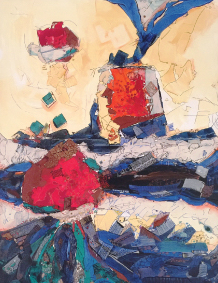 Artist Alhajri has a strong ability in expressing different places and times, either virual or realistically. This might be from his holistic concept of this world. He sees that the earth in all its details is his home, and all people living there are his brothers who breath the same air and share the same sky. The shapes and colours that are used by Al Hajri have clearly indicated this concept. There are paintings that have various shapes and colours that are totally different than the environment of Alhajri. The green colour reflects the memories of Sydney’s trees that are on the edges of the city streets and suburbs when the artist stayed in the middle of this nature.
Artist Alhajri has a strong ability in expressing different places and times, either virual or realistically. This might be from his holistic concept of this world. He sees that the earth in all its details is his home, and all people living there are his brothers who breath the same air and share the same sky. The shapes and colours that are used by Al Hajri have clearly indicated this concept. There are paintings that have various shapes and colours that are totally different than the environment of Alhajri. The green colour reflects the memories of Sydney’s trees that are on the edges of the city streets and suburbs when the artist stayed in the middle of this nature.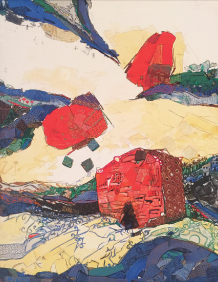 The same thing goes when he used to sit under trees for long periods in the British city of Loughborough. At the level of shapes, many geometrical shapes such as circles, squares and triangles may be intertwined in one artwork, and one geometrical shape may be dominant in the work of art. The waving lines are included in some works of art, and this is an indication of the artist’s sense of music, transferring his passion for this from auditory to a visual. Curved lines indicate the shape of sand dunes in his town Bidiya and the waves of the sea on the shores of the Muscat.
The same thing goes when he used to sit under trees for long periods in the British city of Loughborough. At the level of shapes, many geometrical shapes such as circles, squares and triangles may be intertwined in one artwork, and one geometrical shape may be dominant in the work of art. The waving lines are included in some works of art, and this is an indication of the artist’s sense of music, transferring his passion for this from auditory to a visual. Curved lines indicate the shape of sand dunes in his town Bidiya and the waves of the sea on the shores of the Muscat.
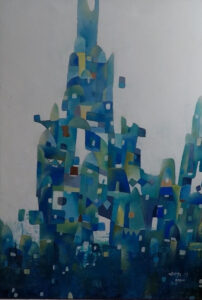 Member of OSFA and YOUTH Studio in Oman; AWG in Muscat and Women’s Guild; Participated in most local exhibitions since 1997 and many international exhibitions in Oman; Exhibited in more than 13 countries all over the world (2000-2014); More than 30 group exhibitions in Oman; Took part in the Painting Project on the Air Force planes in 2013; Participated in the fashion show in Rome 2014; 3 shows in Muscat (2010-2014)
Member of OSFA and YOUTH Studio in Oman; AWG in Muscat and Women’s Guild; Participated in most local exhibitions since 1997 and many international exhibitions in Oman; Exhibited in more than 13 countries all over the world (2000-2014); More than 30 group exhibitions in Oman; Took part in the Painting Project on the Air Force planes in 2013; Participated in the fashion show in Rome 2014; 3 shows in Muscat (2010-2014)
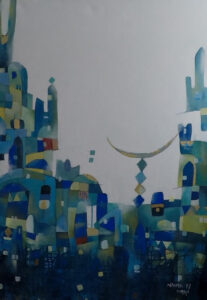 “It’s a spiritual feeling that calls artists all the time, it cannot be ignored. In my work I concentration on the deep relations and movement of people and places, picking inspirations from my roots to reach inner satisfactions.
“It’s a spiritual feeling that calls artists all the time, it cannot be ignored. In my work I concentration on the deep relations and movement of people and places, picking inspirations from my roots to reach inner satisfactions.
Working on canvas leads me to a kind of peace and pleasure. Art including the magnitude of the aesthetic vocabulary takes us to words unheard, or expressing feelings with tools such as acrylics, oils and other different media to translate the core of my subject.
A dialogue spread to fill the whole surface with harmony and silence, dealing with colours and different materials by time lead us to the nature, where I start to match and combine passion in painting with the beauty of gems and natural stones; which, as well as silence, has mysterious stories…
So I moved on completing a journey of beauty with Omani silver treasures and gems, it’s more than a design, it’s a contemporary piece in a traditional touch, therefore I wish for you to enjoy every piece which is designed with love to reach your standards.”
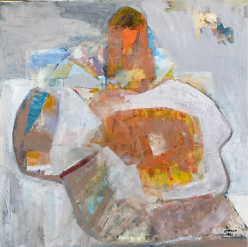 Fattouh joined the Faculty of Fine Arts at the National Institute of the Lebanese University and received his degree in Fine Arts with honours in 1983. Ever since then Fattouh has been a prolific artist. From 1985 to the present he has held over 150 collective and personal exhibitions in Lebanon’s noted art galleries and festivals.
Fattouh joined the Faculty of Fine Arts at the National Institute of the Lebanese University and received his degree in Fine Arts with honours in 1983. Ever since then Fattouh has been a prolific artist. From 1985 to the present he has held over 150 collective and personal exhibitions in Lebanon’s noted art galleries and festivals.
Abroad Fattouh exhibited in California, USA; Romania; England; France; Italy; Spain; UAE; Kuwait; Morocco; Jordan; Oman; Sweden; Switzerland; Cyprus; Tunisia; Greece; Saudia Arabia; as well as at different international auctions such as Bonham’s (London).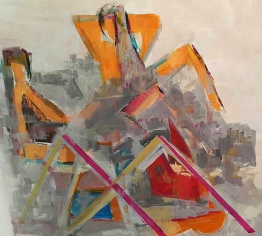 In his exhibition in London he was honoured by Queen Elizabeth II with a medal; he was chosen Artist of the year 2007 and selected as the 4th best artist by Riviera magazine for his exhibition “Byblos, return to my inspiration” in Santa Ana, California, USA.
In his exhibition in London he was honoured by Queen Elizabeth II with a medal; he was chosen Artist of the year 2007 and selected as the 4th best artist by Riviera magazine for his exhibition “Byblos, return to my inspiration” in Santa Ana, California, USA.
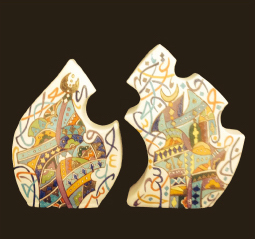 1968 Graduate Diploma of Education Baghdad Institute of Al Adhmiya
1968 Graduate Diploma of Education Baghdad Institute of Al Adhmiya
1972 Educational training course in ceramics, Ministry of Education Baghdad
Member of Association of Iraqi Artists
Founding member of the Emirates Fine Arts society
1976 The first personal exhibition in Iraq
Exhibitions:
Ceramic artworks at the Sharjah Art Museum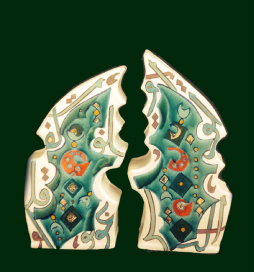
Ceramic artworks in Islamic Calligraphy and Decoration Museum, Sharjah
Ceramic mural implementation of Diwan of the HH, Ruler of the Ajman (measuring 2m x 3m)
Implementation of paintings Ceramics Abu Dhabi landmarks of the Council HH Sheikh Sultan Bin Zayed
Implementation ceramic mural in New Dubai Hospital (measuring 18m x 6m)
Implementation of two ceramic murals in the Public Prosecution building in Dubai (measuring 6m x 4m)
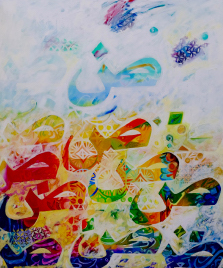 Mona al-Khaja is an Emirati fine artist holding a Bachelors in Art. She is also a member of the Fine Art Association on the Emirates. She has participated in art exhibitions in Sharjah, Dubai, Abu Dhabi, Kuwait, Oman, Cairo, Jordan, Morocco, Bahrain, India, Germany, Japan, France, Spain and Saudi Arabia.
Mona al-Khaja is an Emirati fine artist holding a Bachelors in Art. She is also a member of the Fine Art Association on the Emirates. She has participated in art exhibitions in Sharjah, Dubai, Abu Dhabi, Kuwait, Oman, Cairo, Jordan, Morocco, Bahrain, India, Germany, Japan, France, Spain and Saudi Arabia.
UAE artist Mona al-Khaja uses a bundle of tools to augment many layers in her art. She was never content to employ just one technique, and excelled by using number of handy ingredients such as brushes, rollers and razors.
Mona has been painting since she was a child. She was highly motivated by her art teacher, who used to display artwork on the school signboard. Mona’s father inspired her to persevere, and provided her with all the tools and material she needed to become an artist.
Mona al-Khaja: At the age of 13, I became a member of Women’s Association, and created a painting bought by a leading woman dignitary of the UAE.
Mona studied fine art in Egypt and has participated in a series of art exhibitions in many countries, including Japan, India, Germany, France and Saudi Arabia.
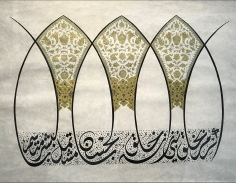 Calligrapher Mohammed Mandi is recognised internationally for an individual style that combines letters and words to form three-dimensional images and figures. Working with different shades and colours, Mandi overlays the lettering in a laborious process that can take years to complete a singular work. By building up the surface in layers, Mandi transforms the two-dimensionality of script into a vibrating, multi-dimensional composition. The result is a breathtaking achievement that forges the textual with the visual, the literal with the symbolic, and the representational with the abstract.
Calligrapher Mohammed Mandi is recognised internationally for an individual style that combines letters and words to form three-dimensional images and figures. Working with different shades and colours, Mandi overlays the lettering in a laborious process that can take years to complete a singular work. By building up the surface in layers, Mandi transforms the two-dimensionality of script into a vibrating, multi-dimensional composition. The result is a breathtaking achievement that forges the textual with the visual, the literal with the symbolic, and the representational with the abstract.
For the artist, calligraphy is the art of the soul. Fascinated by the beauty of calligraphy as a child, Mandi enrolled in the Arabic Calligraphy Improvement School in Cairo, graduating in 1977. He continued his training in Turkey during the 1970s under renowned Turkish calligrapher, Hassan Chalabi. In the 1980s, he returned to the United Arab Emirates, where he has since designed calligraphy for the logos of government ministries, private companies, and commercial establishments. Mandi’s distinctive angular designs are found on banknotes throughout the UAE and Bahrain, and on passports in the UAE, Bahrain, Oman, Qatar, and Kuwait. One of his most notable accomplishments is as one of the designers of the interior calligraphy in the Sheikh Zayed Grand Mosque in Abu Dhabi. Mohammed Mandi lives and works in Abu Dhabi.
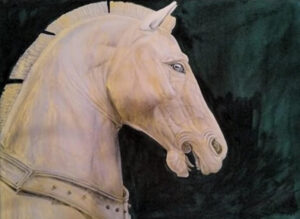 Patrick Faure is a native of the Principality of Monaco and is the creator of Faurism, an art movement for the 21st Century.
Patrick Faure is a native of the Principality of Monaco and is the creator of Faurism, an art movement for the 21st Century.
After gaining recognition in the United States and Continental Europe for producing a comprehensive collection of American Indian portraits, Patrick moved to London to explore a new form of expression. His current paintings merge art, philosophy and poetry in a new concept, Faurism, which ventures into the world of dreams, sexual desire, knowledge and erudition. The result is a synthesis of mythical phantasms, modern human condition and contemporary imagery.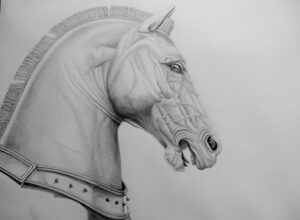 Influence by Platonic and Existentialist though, Patrick challenges the viewer to uncover the intricate messages hidden in every part of his creations. While critics have described his style as “Escher meets Dali”, Patrick does not see himself as a Surrealistic painter. To the opposite he has developed his work into an epic poem, questioning the metaphysics of our existence. Patrick has participated in many exhibitions and counts Pepsi-Cola, NATO, the city of Sierra Vista, the US Army and Torvec Inc. amongst his customers.
Influence by Platonic and Existentialist though, Patrick challenges the viewer to uncover the intricate messages hidden in every part of his creations. While critics have described his style as “Escher meets Dali”, Patrick does not see himself as a Surrealistic painter. To the opposite he has developed his work into an epic poem, questioning the metaphysics of our existence. Patrick has participated in many exhibitions and counts Pepsi-Cola, NATO, the city of Sierra Vista, the US Army and Torvec Inc. amongst his customers.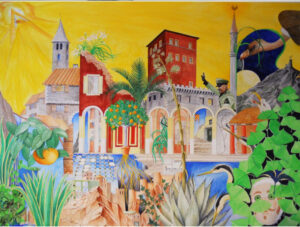 He is being represented by galleries in Istanbul and Italy, and has been selected to present his work together with an essay on Art and Philosophy at the United Nations in November 2017.
He is being represented by galleries in Istanbul and Italy, and has been selected to present his work together with an essay on Art and Philosophy at the United Nations in November 2017.
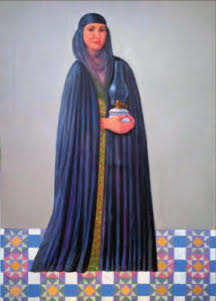 Vision is the art of seeing what is invisible to others
Vision is the art of seeing what is invisible to others
Faisel’s style had already evolved in Baghdad through his artistic exchange with significant Iraqi artists, even before he left for Paris to study at the National Superior School of Fine Arts of Paris in 1974. While abroad, the Iran-Iraq War broke out and was followed after by the Gulf Wars, convoluting the formation of a consistent artistic identity in the third wave of Iraqi contemporary art. Many artists had fled the country but only a few have continued to maintain the lion’s share of attention. Faisel Laibi Sahi created his own creative canon. He became one of Iraq’s leading proponents of the arts, expressing the collective imagination of his country with an aesthetic and language of his own. Pictorial dreams that project nationalist imagery in a trans-cultural dialogue.
The artistic world that Faisel creates is rooted in what it means to be Iraqi. The highly acclaimed Baghdadi Coffee Shop series is Faisel’s answer to Iraq’s late modernisms formulation of painting in terms of flatness and opticality. He gives us an extremely articulate introduction to the Western alternative, the concept of the tableau – new perceptual approaches to reality – Modern Realism.
Last year he celebrated 50 years of painting. His retrospective follows a sequence of forms emulating the once Iraqi social sphere. Rendered in a pop-like colour spectrum, the works demonstrate Faisel’s consummate skill as a painter.
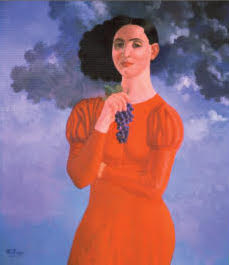 The masterful composition together with an eye for decorative details in planes of pure colour, obliquely unfold stories that tend to abstraction. Without a doubt, his allusion to the figurative is thoroughly conceptual. Quintessential Iraqi scenes are masterfully rendered and cannot be compared to those produced by the most novel of “isms.” It leads us back to the artist dealing with the creation of the self. Faisel is an “other”, as well as all others.
The masterful composition together with an eye for decorative details in planes of pure colour, obliquely unfold stories that tend to abstraction. Without a doubt, his allusion to the figurative is thoroughly conceptual. Quintessential Iraqi scenes are masterfully rendered and cannot be compared to those produced by the most novel of “isms.” It leads us back to the artist dealing with the creation of the self. Faisel is an “other”, as well as all others.
The Iraqi-British artist’s depiction of the magnificent and boisterously epic history of Iraq’s people inspires a whole nation with respect for its history and hope for its future. Faisel Laibi Sahi’s paintings are embedded with a strong social content that examines power relationships between the individual and society – these masterpieces confirms his passionate commitment to Iraq is as undeniable as his genius.
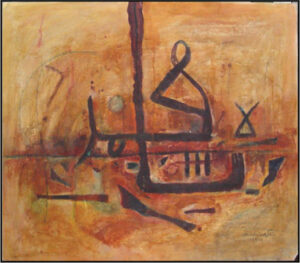 Born in Samawa, Al Said lived, worked and died in Bagdad. He received in 1948 a degree in social science from the Higher Institute of Teachers in Baghdad and in 1954 a diploma in painting from the Institute of Fine Arts in Baghdad where he was taught by Jawad Saleem. He continued his studies at the École nationale supérieure des Beaux-Arts in Paris until 1959, where he was taught by Raymond Legueult. During his stay in Paris, he discovered Western modern art in galleries and Sumerian art at the Louvre. After his return to Baghdad in 1959, Al Said studied the work of Yahya ibn Mahmud al-Wasiti, sufism and Mansur Al-Hallaj. He gradually abandoned figurative expressions and centered his compositions on Arabic calligraphy.
Born in Samawa, Al Said lived, worked and died in Bagdad. He received in 1948 a degree in social science from the Higher Institute of Teachers in Baghdad and in 1954 a diploma in painting from the Institute of Fine Arts in Baghdad where he was taught by Jawad Saleem. He continued his studies at the École nationale supérieure des Beaux-Arts in Paris until 1959, where he was taught by Raymond Legueult. During his stay in Paris, he discovered Western modern art in galleries and Sumerian art at the Louvre. After his return to Baghdad in 1959, Al Said studied the work of Yahya ibn Mahmud al-Wasiti, sufism and Mansur Al-Hallaj. He gradually abandoned figurative expressions and centered his compositions on Arabic calligraphy.
He co-founded in 1951 with Jawad Saleem Jama’et Baghdad lil Fann al-Hadith (Baghdad Modern Art Group), one of the most unusual arts movements in the Middle East in the post–World War II, that aimed to achieve an artistic approach both modern and embracing of tradition. This specific approach was called Istilham al-turath (Seeking inspiration from tradition), considered as “the basic point of departure, to achieve through modern styles, a cultural vision”. He headed the group after the death of Saleem in 1961.
In 1971, he founded Al Bu’d al Wahad (the One-dimension Group)”, which promoted the modern calligraphic school in Arab art.
His work is collected by major museums, such as Mathaf: Arab Museum of Modern Art in Doha, the Guggenheim in New York, and Sharjah Art Museum.
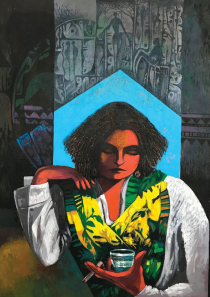 He has participated in more than 300 group exhibitions and 14 solo exhibitions.
He has participated in more than 300 group exhibitions and 14 solo exhibitions.
He is an Egyptian artist who believes the grandest thing in the universe is the human being and the grandest in the human being is the soul. Hence he is occupied in his works by capturing this soul in its different forms. His canvases always include individuals, and in particular women, which represent to him a transparent container of the soul. Through the faces of women he captures the different status of the soul, its reactions, values, problems and deepest secrets.
Magdy Elkafrawy is occupied by the classical composition of the canvas as his colours interact in harmony and balance. He is fond of playing with tones or levels of the same colour, to the extent one might view the one canvas is a display of different tones of the same colour. He also manipulated his favourite colour material – oil – to be malleable and change from its normal coarse nature to the smoothness of watercolours.
The shadows and light in his works change by the change of the light entries and affect the tone of colour.
Decoration also has a prominent place in his works. If individuals are the soul of the canvas, the decoration is the geography of the soul, its history, places and stories of abundant details which tell you a new story every time you look at it.
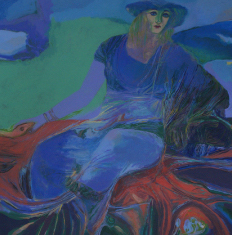 Satta has an MA in Fine Arts (1989) in Mural Painting and Decorative Arts from Leningrad Vera Mukhina Higher School of Art and Design, Leningrad, USSR.
Satta has an MA in Fine Arts (1989) in Mural Painting and Decorative Arts from Leningrad Vera Mukhina Higher School of Art and Design, Leningrad, USSR.
Satta is represented in a number of collections, including drawings in the British Museum’s permanent collections, and paintings in the Museum of Contemporary Arts, Kaliningrad, Russia; Leicester Museum & Art Gallery, Leicester, UK; Stockholm City Council, Sweden; Handelsbanken, Stockholm, Sweden; and many private collections.
In 2010, a hall at the Adult Education College, Leicester, containing two of his mural paintings was renamed Satta Hashem Hall.
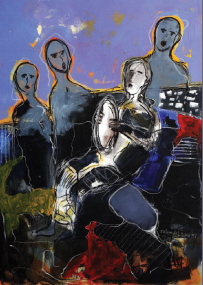 Salem Al Junibi is a member of the “Emirates Fine Art Society” and has participated in several art exhibitions in many countries as well as having a solo exhibition. In 2015 he joins us at the 2nd and 3rd Konooz Fine Art Auction & Exhibitions in London, UK.
Salem Al Junibi is a member of the “Emirates Fine Art Society” and has participated in several art exhibitions in many countries as well as having a solo exhibition. In 2015 he joins us at the 2nd and 3rd Konooz Fine Art Auction & Exhibitions in London, UK.
His vision is to hold to the real movement of music in the Arab Melodies, not only through rhythm but also through his feelings as this melody is part of his soul.
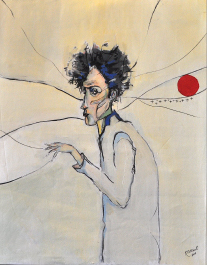 Born in 1996, Rebecca started to paint and sculpt at a very young age.
Born in 1996, Rebecca started to paint and sculpt at a very young age.
At the age of twelve she started to paint. Later she studied Architecture because she always loved to design buildings, houses and museums.
She has exhibited her paintings in Lebanon (Beirut, Jbeil), UAE (Dubai, Abu Dhabi), Saudi Arabia (Jeddah), Italy (Milano), France (Paris), Sultanate of Oman (Muscat) and South Africa (Johannesburg).
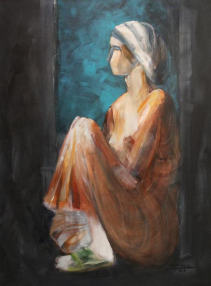 Born in Baghdad 1945, Naman Hadi has lived and worked in Paris since 1971.
Born in Baghdad 1945, Naman Hadi has lived and worked in Paris since 1971.
Graduated from the Academy of Fine Art, Baghdad in 1967 and from the Higher National School of Fine Arts, Paris in 1977. Co-founder of the Academicians Group, Iraq.
Won the first prize of the Paul-Louis Weiller Portrait Prize, awarded by the Institute of France Academy of Fine Arts, Paris in 1975 (363 participants from several countries). They also received Honourable Distinction by the Salon des Artistes Francais in the Museum of Grand Palais, Paris.
In Baghdad, the National Museum of Modern Art acquired many of his works.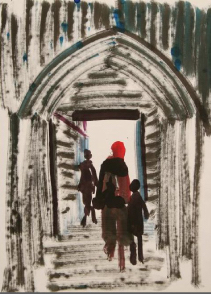 Major exhibitions and activities in France:
Major exhibitions and activities in France:
Gallery Soulange; Grand Palais Museum; Marine’s Museum; Higher National School of Fine Arts, Paris; Gallery Image, Space Regard in George Pompidou Centre; Salon des Beaux Arts of Enghien-les Bains; Fontenay-le-Coomte; Chateau de Castille; Casino Municipale de Cannes; Regard sur la Peinture Arabe; Foire Internationale de Rennes; Rhone Poulenc; Centre culturel Andre Malraux; Antinea Gallery; Le corps découvert in the Intstitut du monde arabe;
Exhibitions abroad:
New Grafik, Berlin; Museum of Modern Art, Baghdad
Ireland: Clifden Art Festival; Grand Fine Art Gallery; Trist Ann’s Gallery
UK: Poster Exhibition, Kufa Gallery, Strokes of Genius in London, Exeter and Bath
USA: Chicago and Lake Forest
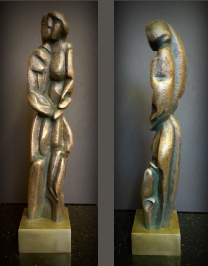 Diploma in Sculpting from the Fine Arts Institute, Baghdad 1981 Professional Development Sculpture Advance Diploma from Kensington and Chelsea College, London – UK 2014 Exhibition in Diana Park, Malmö, Sweden with Sculptures, Skåne Foundation 2006 (Vi Kommer “Dar folket ar”) Voluntary Action Westminster Exhibition with Iraqi Fine Artist Association, London – UK 22/10/2009 Exhibition (Harmony) with Iraqi Fine Artist Association, City Hall, Tower Bridge, London – UK 19/02/2010-26/02/2010 A Call for Meditation with Iraqi Fine Artists in Strand Gallery, London – UK 8/11/2010-14/11/2010 Art Exhibition with Arab artists in the UK, First Arab Cultural Festival, Camden Centre, London – UK 26/6/2011 Surface and Features Annual Exhibition with Iraqi Fine Artists at Walls Art Gallery, Dubai – UAE 19/11/2011-26/11/2011
Diploma in Sculpting from the Fine Arts Institute, Baghdad 1981 Professional Development Sculpture Advance Diploma from Kensington and Chelsea College, London – UK 2014 Exhibition in Diana Park, Malmö, Sweden with Sculptures, Skåne Foundation 2006 (Vi Kommer “Dar folket ar”) Voluntary Action Westminster Exhibition with Iraqi Fine Artist Association, London – UK 22/10/2009 Exhibition (Harmony) with Iraqi Fine Artist Association, City Hall, Tower Bridge, London – UK 19/02/2010-26/02/2010 A Call for Meditation with Iraqi Fine Artists in Strand Gallery, London – UK 8/11/2010-14/11/2010 Art Exhibition with Arab artists in the UK, First Arab Cultural Festival, Camden Centre, London – UK 26/6/2011 Surface and Features Annual Exhibition with Iraqi Fine Artists at Walls Art Gallery, Dubai – UAE 19/11/2011-26/11/2011
“I like to talk about my sculpture and the mean of the work that I make. Each piece can be interpreted in many different ways. I want to illustrate the history of human right. Many of them try explain what’s happened in cultural life, they also tell dreams in different ways. I use my soul and feeling to give a strong voice often about specific events. To show the viewer the feeling of pain when people who live near us are lost or a story filled with the dark side of our sad memories. The materials I work with are sometimes plaster, clay, hard stone, wood or often mixed media and various found objects. I feel that my long experience as sculptor working with different materials has given a life and movement to my recent sculptures as they are presented. “
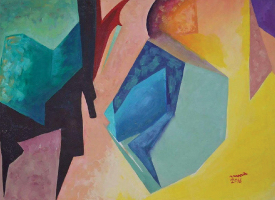 Born in Iraq in 1951, he joined the Academy of Fine Art in 1969 and was educated by the legend “Fae’eq Hassan”.
Born in Iraq in 1951, he joined the Academy of Fine Art in 1969 and was educated by the legend “Fae’eq Hassan”.
His art work added value to the march of the Iraqi Art and the International Art
Hassan Latif participated in several local and international exhibitions including: The third Exhibition of Fine Arts of the Arab Youth The fourth Art Gallery The Arab Youth Political Poster Exhibition in Cuba Exhibition of the Impressionists in Syria
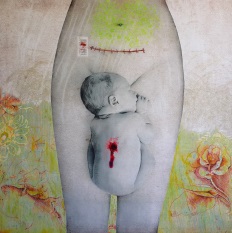 Born in Cairo in 1977, Dr. Nadia Wahdan is a painter and a professor of Drawing and Painting at Helwan University’s Faculty of Art Education. She holds a BA, MFA and a PhD in Art Education from Helwan University, and she is a member of the Fine Artists Syndicate, and the Association of Art Education Graduates. Wahdan has held and participated in several art workshops in Egypt, and has participated in several national and international art conferences and festivals, including the First Digital Art Festival in Egypt in 2013. She has held several solo exhibitions, including a show at the Ahmed Bassiouny Art Gallery in 2012, and she has participated in over 21 group art exhibitions in Egypt and abroad, including shows at Helwan University, Cairo Atelier, the Palace of Arts, Prince Taz Palace, El Hanager, as well as Gallery Jeddah in Saudi Arabia. Her artwork is part of private collections in Egypt, Italy, Saudi Arabia and the UAE. She is the recipient of several awards, including the Salon Prize at the Middle East International Fine Arts competition in 2012.
Born in Cairo in 1977, Dr. Nadia Wahdan is a painter and a professor of Drawing and Painting at Helwan University’s Faculty of Art Education. She holds a BA, MFA and a PhD in Art Education from Helwan University, and she is a member of the Fine Artists Syndicate, and the Association of Art Education Graduates. Wahdan has held and participated in several art workshops in Egypt, and has participated in several national and international art conferences and festivals, including the First Digital Art Festival in Egypt in 2013. She has held several solo exhibitions, including a show at the Ahmed Bassiouny Art Gallery in 2012, and she has participated in over 21 group art exhibitions in Egypt and abroad, including shows at Helwan University, Cairo Atelier, the Palace of Arts, Prince Taz Palace, El Hanager, as well as Gallery Jeddah in Saudi Arabia. Her artwork is part of private collections in Egypt, Italy, Saudi Arabia and the UAE. She is the recipient of several awards, including the Salon Prize at the Middle East International Fine Arts competition in 2012.
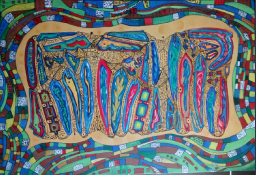 High Diploma in Interior Design from Institute Beirut in 1983
High Diploma in Interior Design from Institute Beirut in 1983
High Diploma in Fine Art 1988 from Lebanese University of Fine Arts
Member of Union Plastic Art in Lebanon
Member of Union Plastic Art in UAE
Member of Art & Festivals in Beirut, Tyr and Beitedeen
Member of Union Artists TV & Theatre, Lebanon
Exhibitions:
– Beirut Siosuq Gallery 1987 Lebanon
– Biennali of First Art Exhibitions 1989 UAE – Shj
– Personal Exhibition 1999 Kuwait
– Abu Dhabi Culture Foundation 2000
– Art Exhibition & Auction with Konooz and Cristie’s Gallery in London 2015
Projects in Dubai:
– Sheraton Hotel Abu Dhabi extension coordinator with tiled company and khateeb Alami
– Millenium Hotel Shj – full fit out and Art
Special Activities:
– Beirut Art Carnivals 1983 Beruit (include Big Sculptures many shapes)
– Special Decor with Drawing Arts for Bicadly Theatre (with Yaccoub Al Shedrawi) 1984
– Special Decor and Art Painting for stage on theatre Sarola 1985 Beirut
Badr Abbas is an Emirati artist who has had his work exhibited in local and international venues. Badr’s love for art began as a boy while dabbling in artistic competitions. Recognition from school, friends, family and awards led this passion into a serious hobby. Today, a member of the Emirates Fine Arts Society, Badr’s work displays Emirati folk heritage and uses symbols from old Arab traditions and culture. He expresses himself with his unique interpretation of simplified cubism. Although Badr started as a realistic painter in a classical style, his work has evolved into a unique and distinct style of art.
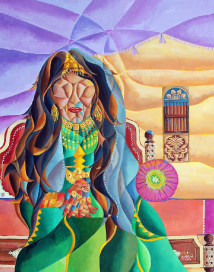 “The Bride”
“The Bride”
This piece of art represents a cubist style painting of a traditional Emirati bride. She shows off her most exquisite jewellery and ornaments, long plaited hair, a green colour dress embroidered and crocheted in gold and silver threads, bracelets, bangles and rings. Traditional gold ornaments on her forehead, she is wearing a traditional necklace tightened around her neck called “murt’asha” decorated with semi-precious stones of red and green, as well as the “muriya” gold necklace on the chest. The bride’s henna decorated hands are adorned with four rings, all in different designs. Her forearm fitted with thin bracelets, long decorated earrings also in semi-precious stones of red and green. This is typical of what a traditional bride would wear on her henna night. The bride is sitting on a big chair with embroidered cushions. The wedding ceremony is an important event in the Emirati folk heritage and culture. The vibrant colours of green, magenta, red and blue make the elements of the painting come to life in a distinct style of art.
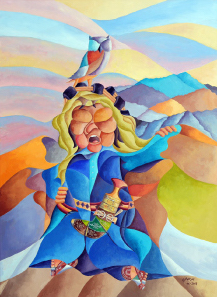 “Bedouin Boy & his Owl”
“Bedouin Boy & his Owl”
This piece of art showcases the harsh life in the desert that gave the chance to the Bedouins to deeply understand the wildlife that exists in the environment. This cubism painting focuses on the traditional lifestyle, clothing is a head cover known as “ghutrah” to protect the bedouin from the sun, dust and sand, held in place by a doubled rope called “Agal”, and the Arabian dagger known as “Khanjar” is worn as an accessory to his clothing. The Painting also shows the bond people had with their pets; in this case “The Owl”. With the absence of luxury, means of entertainment, and friends, a pet would be one’s best friend and lifetime companion. This painting is a quintessential display of Badr’s distinct style of art that is deep-rooted in his love for history.
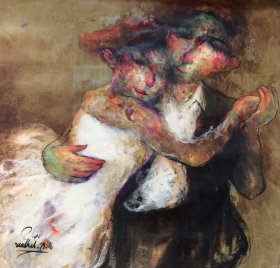 Wadhah Mahdi (1974) was born and raised in Baghdad. He earned a degree from the Institute of Fine Arts in 2000. Wadhah left Iraq in 2005 to escape the dangerous situation in his country; later he returned to Baghdad where he lives and works now. His paintings are narrative, recognisable situations or snapshots; painted in a woolly style with a rich, warm colour palette. Wadhah has always fought for women’s rights “because women’s rights, in my opinion, is missing in my country.” Although the difficult situation in his country is an important theme in his life, his works of art show, above all, beauty and love.
Wadhah Mahdi (1974) was born and raised in Baghdad. He earned a degree from the Institute of Fine Arts in 2000. Wadhah left Iraq in 2005 to escape the dangerous situation in his country; later he returned to Baghdad where he lives and works now. His paintings are narrative, recognisable situations or snapshots; painted in a woolly style with a rich, warm colour palette. Wadhah has always fought for women’s rights “because women’s rights, in my opinion, is missing in my country.” Although the difficult situation in his country is an important theme in his life, his works of art show, above all, beauty and love.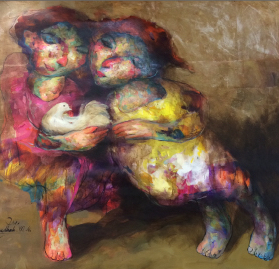
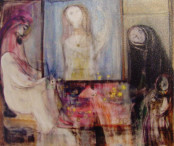 Naziha Salim (1927-15 February 2008) was an Iraqi artist and painter described by the country’s president Jalal Talabani as “the first Iraqi woman who anchored the pillars of Iraqi contemporary art.
Naziha Salim (1927-15 February 2008) was an Iraqi artist and painter described by the country’s president Jalal Talabani as “the first Iraqi woman who anchored the pillars of Iraqi contemporary art.
Naziha Salim was born into a family of Iraqi artists living in Turkey. Her father was a painter while her brother, Jawad Salim, has been cited as one of Iraq’s most important modern sculptors. In the 1940s she graduated from the Baghdad Fine Arts Institution and continued her education in Paris. In the 1960s Salim returned to the Fine Arts Institute as a teacher and remained at the school until her retirement in the 1980s.
Naziha Salim suffered a stroke In 2003, which left her paralysed. She lived for another five years. dying in Baghdad at the age of 81. President Jalal Talabani called her death a “big loss to Iraqi art and culture.”
 MERCY Malaysia UK (MMUK) is a medical and humanitarian charity, based in London, providing assistance to beneficiaries both in the UK and abroad. It operates as a non-profit, non-religious and non-political organisation; focusing on providing medical relief, sustainable health-related development and risk reduction activities to vulnerable communities, particularly in crisis. Established in September 2014, MMUK has worked relentlessly to raise its profile in the UK, from donating funds to flood victims in York, UK to providing educational support to the Syrian refugee community in Nottingham, UK. Currently MMUK is working with other NGOs in a project called Drum for Hope, a weekend cultural activity for a group of refugee children in Nottinghamshire as part of their psychosocial support. MMUK is also striving to provide medical assistance to a group of Syrian refugees with chronic illnesses and disabilities in Bekaa Valley camps, Lebanon – which include funding for their prosthetic limbs.
MERCY Malaysia UK (MMUK) is a medical and humanitarian charity, based in London, providing assistance to beneficiaries both in the UK and abroad. It operates as a non-profit, non-religious and non-political organisation; focusing on providing medical relief, sustainable health-related development and risk reduction activities to vulnerable communities, particularly in crisis. Established in September 2014, MMUK has worked relentlessly to raise its profile in the UK, from donating funds to flood victims in York, UK to providing educational support to the Syrian refugee community in Nottingham, UK. Currently MMUK is working with other NGOs in a project called Drum for Hope, a weekend cultural activity for a group of refugee children in Nottinghamshire as part of their psychosocial support. MMUK is also striving to provide medical assistance to a group of Syrian refugees with chronic illnesses and disabilities in Bekaa Valley camps, Lebanon – which include funding for their prosthetic limbs.
By the end of 2017, MMUK will deploy a surgical medical mission to provide free reconstructive cleft lip and palate to underprivileged children in Myanmar. 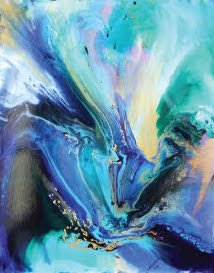 Alongside their humanitarian work, MMUK activities include fundraising, campaigning at public events and hosting humanitarian talks. MMUK rely solely on funding from organisations and donations from generous individuals.
Alongside their humanitarian work, MMUK activities include fundraising, campaigning at public events and hosting humanitarian talks. MMUK rely solely on funding from organisations and donations from generous individuals.
Website: http://mercy.uk.com/
Auction item for MMUK: Aber Al Farhan – Chromatic abstraction (left)
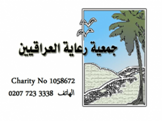 Iraqi Welfare Association is a leading and well known registered charity (Reg. No. 1058672), established over 25 years ago.
Iraqi Welfare Association is a leading and well known registered charity (Reg. No. 1058672), established over 25 years ago.
We carry out several activities and run projects to help to integrate the Iraqi community within the British society, as well as promote and enhance the Iraqi rich culture and history in Britain.
Some of the main activities:
– Provide advice and help to members of the Iraqi and Arab community in the UK
– Run courses, training and seminars
– Children’s summer camps over 24 years
– Organising family gatherings every year for the last 18 years
– Run a ladies-only gym in Neasden
– Publish a leading community magazine called Al-Mahjer for the past 24 years
Website: http://www.iraqiwelfare.com/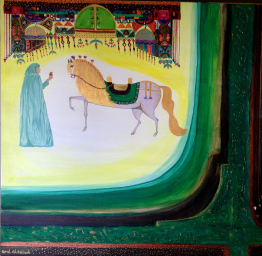
Auction item for Iraqi Welfare Association: Amal Al Zubaidi – The self & the soul (left)
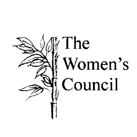 The Women’s Council has worked throughout its long history with women from Asia and Asia Pacific for the empowerment of their fellow countrywomen. It has always had the education of woman at its heart Some 40 years ago, in consultation with its Patrons who represent over 20 countries in Asia/Asia Pacific, it changed its focus so as to concentrate on specialised further training for women working with children with disabilities, with an emphasis on inclusive education and rehabilitation. It currently sponsors an annual three month course for up to 20 women who are social workers, doctors, teachers and trainers, followed by a three month practicum in their own organisations, devised by them during the course. Almost 300 women have taken part and countless thousands of such disadvantaged children and their families have benefited.
The Women’s Council has worked throughout its long history with women from Asia and Asia Pacific for the empowerment of their fellow countrywomen. It has always had the education of woman at its heart Some 40 years ago, in consultation with its Patrons who represent over 20 countries in Asia/Asia Pacific, it changed its focus so as to concentrate on specialised further training for women working with children with disabilities, with an emphasis on inclusive education and rehabilitation. It currently sponsors an annual three month course for up to 20 women who are social workers, doctors, teachers and trainers, followed by a three month practicum in their own organisations, devised by them during the course. Almost 300 women have taken part and countless thousands of such disadvantaged children and their families have benefited.
Website: http://www.womenscouncil.org.uk/

Auction item for The Women’s Council: Chucrallah Fattouh – Surrounding a Strange Body 2 (left)
 World Wide Welfare was established after the Gulf war in 1991. The main aim was to help women who were widowed after the war, who were left with many orphans, no husband to support them and no hope for the future. Today, with a strong team of volunteers who freely dedicate their time and efforts for this cause, not only does WWW sponsor orphans, but they also help to improve the living standards of all of the cases they come across. All of the money raised from today will go towards the sponsorship of a special autism centre in Basra.
World Wide Welfare was established after the Gulf war in 1991. The main aim was to help women who were widowed after the war, who were left with many orphans, no husband to support them and no hope for the future. Today, with a strong team of volunteers who freely dedicate their time and efforts for this cause, not only does WWW sponsor orphans, but they also help to improve the living standards of all of the cases they come across. All of the money raised from today will go towards the sponsorship of a special autism centre in Basra.
Website: www.worldwidewelfare.org

Auction item for WWW: Mayassah Alsader – Field of carnation (left)
 People Act for Tunisia (PAcT), a UK registered charity, is committed to promoting equal opportunities in Tunisia through education and relief of poverty Our Mission: Advance education by:-
People Act for Tunisia (PAcT), a UK registered charity, is committed to promoting equal opportunities in Tunisia through education and relief of poverty Our Mission: Advance education by:-
* Provision of school materials and equipment
* Refurbishment and building of schools and libraries
* Training teachers
* Providing Transport to school
Relief of poverty by:-
* Provision of food, clothing and shelter
* Assisting the unemployed by giving advice and training
* Providing access to basic utility services for homes in difficult areas
Website: http://www.pactunisia.org.uk/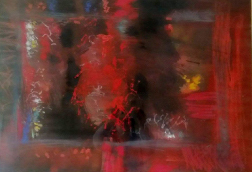
Auction item for PAcT: Fethi Zbidi – Red Resonance (left)
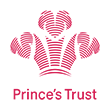 The Prince’s Trust helps disadvantaged young people to get their lives on track. It supports 13 to 30 year-olds who are unemployed and those struggling at school and at risk of exclusion. Many of the young people helped by The Trust are in or leaving care, facing issues such as homelessness or mental health problems, or have been in trouble with the law. The Trust’s programmes give vulnerable young people the practical and financial support needed to stabilise their lives, helping develop self-esteem and skills for work. Three in four young people supported by The Prince’s Trust move into work, education or training. The Prince of Wales’s charity has helped 825,000 young people since 1976 and supports over 100 more each day.
The Prince’s Trust helps disadvantaged young people to get their lives on track. It supports 13 to 30 year-olds who are unemployed and those struggling at school and at risk of exclusion. Many of the young people helped by The Trust are in or leaving care, facing issues such as homelessness or mental health problems, or have been in trouble with the law. The Trust’s programmes give vulnerable young people the practical and financial support needed to stabilise their lives, helping develop self-esteem and skills for work. Three in four young people supported by The Prince’s Trust move into work, education or training. The Prince of Wales’s charity has helped 825,000 young people since 1976 and supports over 100 more each day.
In the year ahead, The Trust aims to support 60,000 vulnerable young people across the UK, helping to give them the skills and confidence to find a job.
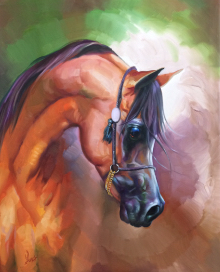 Website: https://www.princes-trust.org.uk/
Website: https://www.princes-trust.org.uk/
Auction item for The Prince’s Trust: Ahmed Kadhum – Portrate (left)
Videos
Details
- Date:
- January 28, 2017
- Time:
-
8:00 am - 5:00 pm
- Event Category:
- Konooz Fine Art Auction

